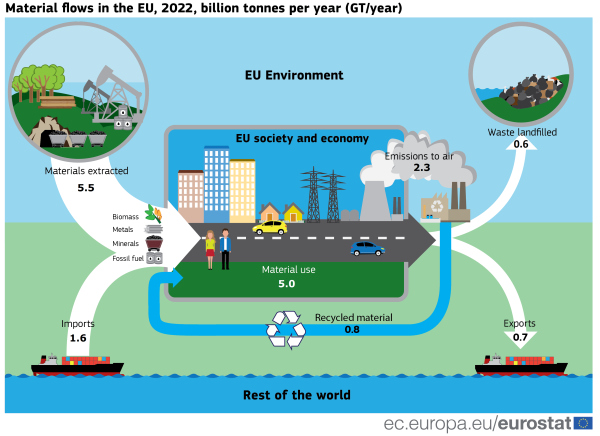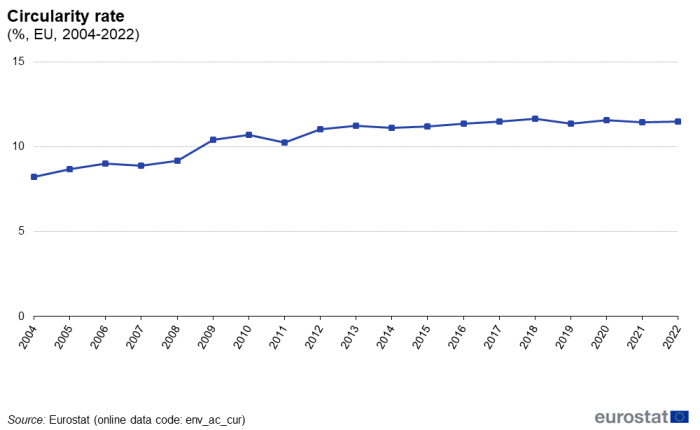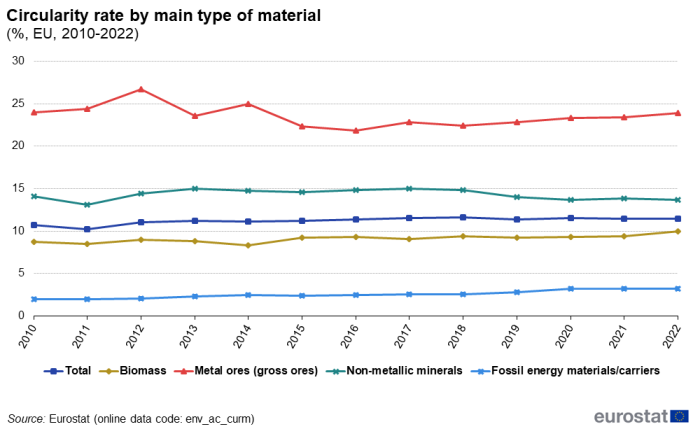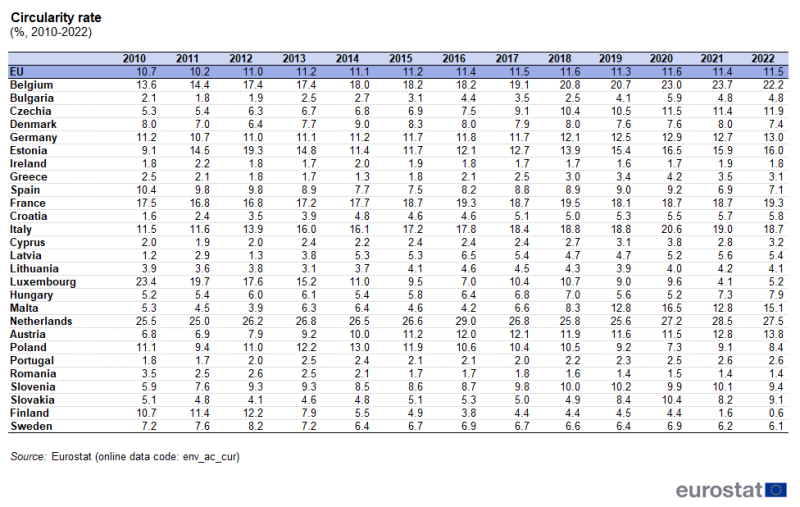Circular economy - material flows
Data extracted in November 2023.
Planned article update: November 2024.
Highlights
In 2022, the rate of circularity of material use in the EU was 11.5 %, 3.3 percentage points (pp) up from 2004.
This article elaborates on two Eurostat statistical products related to the circular economy, namely 1) a Sankey diagram of material flows in the European Union (EU); and 2) the circular material use rate or circularity rate, i.e. the share of material recycled and fed back into the economy.
Both the Sankey diagram and circularity rate form part of the EU monitoring framework for the circular economy. The purpose of a circular economy is to maintain the value of products, materials and resources for as long as possible by returning them into the product cycle after they have reached the end of their lifecycle, while minimising the generation of waste. Materials such as biomass, metals, minerals and fossil fuels are extracted from the environment to make products or to produce energy. When their life cycle ends, products may be recycled, incinerated, or discarded as residual waste. Those material flows are an essential part, albeit not the only one, of the circular economy. The fewer products we discard and the more we recycle, the fewer materials we extract, thus benefiting our environment.
Full article
Sankey diagram of material flows
A Sankey diagram of material flows presents the flows of:
- materials extracted to make products or be used as a source of energy;
- products flowing in and out of our society;
- materials and products discarded into the environment as residuals, e.g. landfilled waste or air emissions, or recovered and fed back into the economy; this latter part closes the loop in the circular economy.
Infrastructure such as buildings, roads, and machinery are used over a long period during which they mount up in our societies, until they are eventually dismantled or taken out of use.
The Eurostat Sankey diagram of material flows shows the amounts of materials extracted, imported, recycled or disposed, as well as related emissions. Figure 1 shows the flows of material in the EU economy in 2022. Some basic information to help understand the diagram:
- the flow runs left to right;
- the width of the bands is proportional to the quantity of the flow, which is measured in billions of tonnes (billion tonnes = Gt);
- the materials shown in the diagram are: biomass - used for food and fodder, clothing (wool, cotton, etc.), timber, etc.; metals; non-metallic minerals; fossil energy carriers, such as crude oil - used to produce fossil fuels or materials such as plastics. Water is not included, nor are renewable energy sources that do not involve material flows, such as electricity from photovoltaic panels or wind power;
- fossil fuel carriers and biomass (wood) produce air emissions — shown on the right side of Figure 1 — as a result of being burned to release energy.
Figure 1 also displays imports and exports, which are flows of materials, products and waste between different economies. The closed loop represents residuals that are not discarded into the environment but are reused in the economy, either to produce secondary raw materials or for other purposes, preventing further extraction of natural resources. The incineration of waste to produce energy is not part of the loop but has its own flow and eventually produces air emissions.
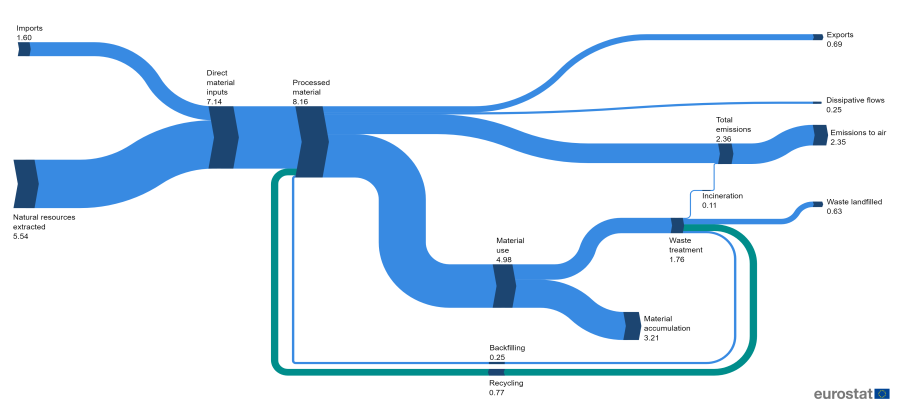
(billion tonnes = Gt)
Source: Eurostat (env_wassd) (env_ac_mfa) (env_ac_sd)
Figure 1 shows that 68 % (5.54 Gt) of raw materials processed in the EU (8.16 Gt) originate from domestic extraction, 20 % from imports (1.60 Gt) and 12 % from recycling and backfilling (1.02 Gt), while 61 % of raw materials processed were used to make products (4.98 Gt). The rest were mainly exported or used for producing energy.
The next sections explain in more detail the different parts of Figure 1.
Description of flows and nodes of the Sankey diagram
Eurostat's Sankey diagram is built on a series of nodes, which represent events or processes, e.g. imports and material inputs. The connections between the nodes represent material flows. Figure 2 is an excerpt of the left side of Figure 1 showing the inputs into the EU economy.
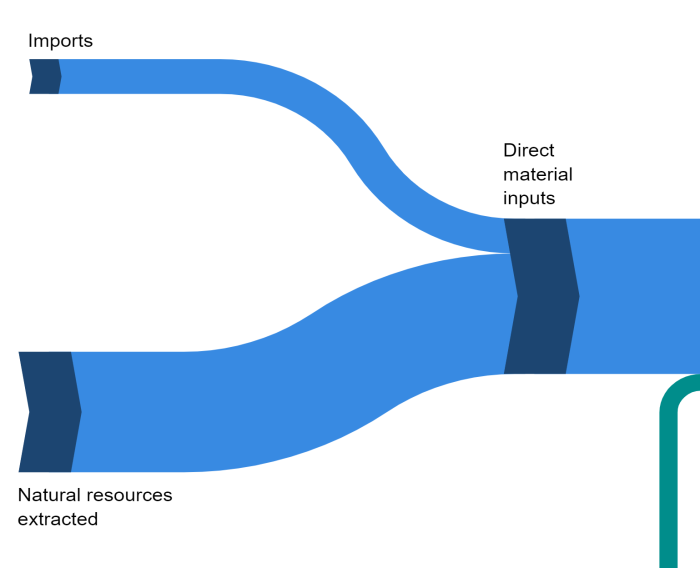
(billion tonnes = Gt)
Source: Eurostat (env_ac_mfa) (env_ac_sd)
- Imports are flows of products from the rest of the world economy into the domestic economy. This flow also includes waste sent for treatment (e.g. converted into secondary raw material) in the receiving country.
- Natural resources refers to the amount of material resources extracted from the natural environment by resident production units. This concept is called domestic extraction (DE).
- Direct material input (DMI) shows the direct input of material that is directly fed into the economy. It is the sum of domestic extraction and imports. DMI includes all materials of economic value, which are available for use in production (e.g. manufacture) and consumption (e.g. purchase of manufactured goods).
The middle part of the Sankey diagram (Figure 3) shows processed materials, which are defined as the sum total of DMI and secondary material input, i.e. materials from recycling and backfilling. Processed materials can either be exported or used domestically. The part not exported is called domestic material consumption (DMC).
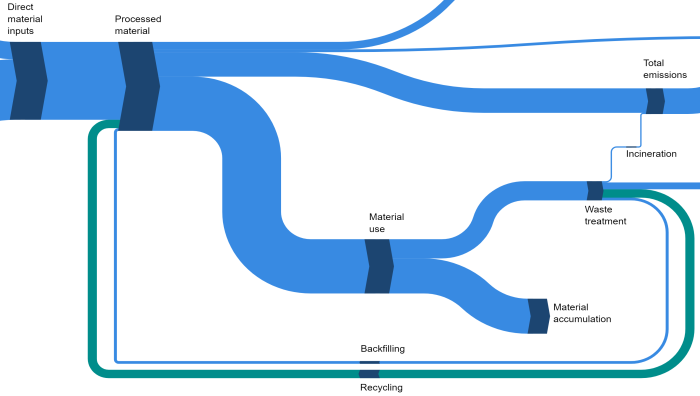
(billion tonnes = Gt)
Source: Eurostat (env_wassd) (env_ac_mfa) (env_ac_sd)
In Figure 3, the share of the green loop in the 'processed materials' node is a possible indicator of the economy's circularity. The share represents recovered waste materials from recycling and backfilling as a proportion of all materials processed. A more sophisticated indicator, called the circularity rate, is presented below. Materials and products may have a short or long lifecycle. Some are:
- single use (e.g. food);
- used for less than 1 year (e.g. paper);
- long-life products (e.g. furniture);
- assets (e.g. buildings, machinery).
In particular, a large share of construction minerals are used to extend or maintain in-use stocks of, among other things, buildings and infrastructure. These stocks often stay in use for decades and only become available for recycling when they reach the end of their lifecycles. These materials accumulate as the economy grows: each year materials add to the economy's stock — i.e. gross additions to stock — and some old materials are removed as buildings are demolished and durable goods disposed of — i.e. removals. In 2022, the EU's net material accumulation amounted to 3.21 Gt. As long as the demand for raw materials for in-use stocks with long life-times (e.g., buildings and infrastructure) exceeds the amount of materials that can be supplied from recycled materials, primary extraction will remain necessary.
The right side of the Sankey diagram shows the outputs from the economy (Figure 4):
- exports of products in their simple mass weight;
- emissions to air and emissions to water — flows of solid, liquid and gaseous materials that are discharged into water bodies (rivers, seas, etc.) or emitted into the atmosphere;
- dissipative flows — materials which are dispersed into the environment - with current technology - as a deliberate or unavoidable consequence of product use, for example, mineral fertilisers and abrasion from tyres.
Several outputs come from the 'waste treatment' node.
- Incineration: waste is incinerated to extract energy. However, this also produces air emissions.
- Waste landfilled: disposal of waste including landfill and other operations.
- Recovery: operations involving waste materials being reprocessed into products, materials or substances to be reused either for their original purpose or other purposes. It includes recycling and backfilling operations.
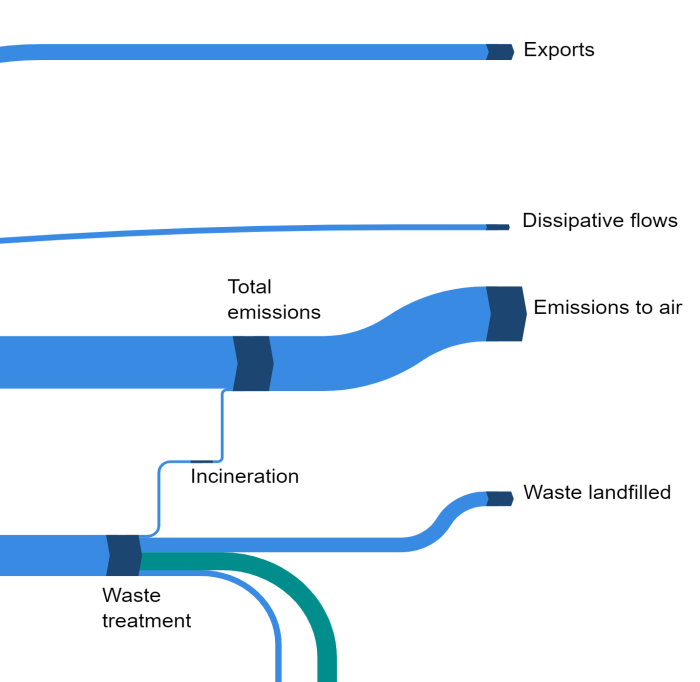
(billion tonnes = Gt)
Source: Eurostat (env_wassd) (env_ac_mfa) (env_ac_sd)
In Eurostat's Sankey diagram, only recycling and backfilling flows are deemed to close the loop of the circular economy (some other researchers and experts also consider the recovery of energy). In 2022, recycling and backfilling flows involved around 12 % of overall material inputs to the EU economy.
The waste produced by the use of materials, including the material removed from the stocks at end-of-life (demolition & discards) accounted for 1.76 Gt in 2022. Part of this waste remains in the EU economy through recycling (0.77 Gt) and through backfilling (0.25 Gt). The recycling stream is 44 % of all material waste flows, whereas backfilling is 14 % and landfilled waste is 36 %. Some of the waste is incinerated and part of it (0.11 Gt) is released into the environment, together with other emissions, as for example, emissions to air (2.35 Gt). The outputs in Figure 4 are completed by exports (0.69 Gt) and dissipative flows (0.25 Gt).
The recycling rate is the share of recycled waste out of all the waste treated. It varies significantly by material category, paper, glass, metals, plastics, etc. For this reason, recycling rates are more frequently analysed by material category than for the whole economy. Recycling rates are highest for metals and lowest for fossil fuels.
Breakdown by type of material
It is possible and relevant to consider the flows with a breakdown by material categories. An analysis by material category conveys the relative significance of various materials and their potential for reuse, recovery or recycling.
The material flows data for this Sankey diagram are currently divided into four main categories: biomass (MF1), metal ores (MF2), non-metallic minerals (MF3) and fossil energy carriers/materials (MF4). Work is ongoing to improve the granularity of the categories, e.g. by isolating plastics.
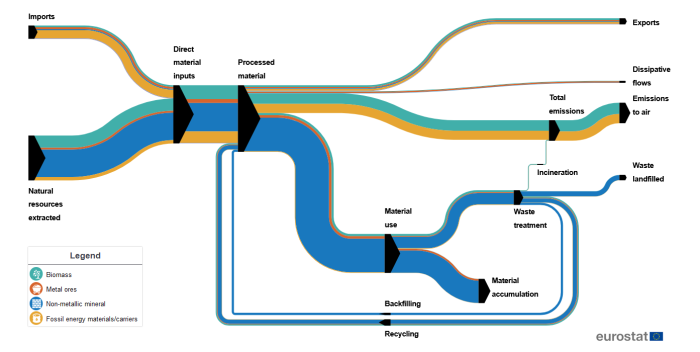
(billion tonnes = Gt)
Source: Eurostat (env_wassd) (env_ac_mfa) (env_ac_sd)
Circularity rate
As there was no single summary indicator for the circularity of our economies at macroeconomic level, Eurostat developed a new indicator for the EU monitoring framework for the circular economy. This new indicator is called the 'circular material use rate' — referred to as the circularity rate — and it measures the contribution of recycled materials towards the overall use of materials.
The circularity rate is the share of material resources used in the EU which came from recycled waste materials, thus saving primary raw materials from being extracted. A higher circularity rate means that more secondary materials replace primary raw materials, thus reducing the environmental impacts of extracting primary material.
In 2022, the EU's circularity rate was 11.5 %, slightly up compared with the previous year and 3.3 percentage points (pp) up from 2004, the first year for which data are available.
The circularity rate is lower than other indicators of circularity, such as recycling rates, which are around 46 % in the EU. This is because some types of materials cannot be recycled, e.g. fossil fuels burned to produce energy or biomass consumed as food or fodder. This can be seen by comparing the size of the nodes at the beginning and the end of the green feedback loop in Figure 1. Examples of materials which are counted within the circularity rate are food and fodder, and fossil fuels for energy production or for material use — e.g. plastics, buildings, infrastructure, and vehicles. Only some of these materials, at the end of their life cycle, end up as waste and thus count in recycling rates. A higher circularity rate can be achieved in more ways than higher recycling rates and requires deeper transformation within our societies, e.g. replacing fossil fuel carriers by renewable energy — hydro power; tide, wave and ocean; wind power; solar photovoltaic; solar thermal and geothermal, by using more efficient production technologies or extending the lifespan of products.
Similarly as the recycling rates, the circularity rate shows big differences by material category. In 2022, the circularity rate in the EU was 24 % for metal ores, 14 % for non-metallic minerals (including glass), 10 % for biomass (including paper, wood, tissue, etc.), and 3 % for fossil energy materials (including plastics and fossil fuels). Fossil fuel materials are less suitable for recycling because they are mainly used for energy purposes, implying that they are transformed into air emissions. However, a lot of progress is possible in the recycling of plastics. Biomass is also partly unsuitable for recycling — e.g. food and fodder or wood for energy — but progress is possible by means of reducing food waste, recycling natural fabrics, etc.
Table 1 shows the circularity rate for the EU and its Member States between 2010 and 2022.
In 2022, the circularity rate was highest in the Netherlands (27.5 %), followed by Belgium (22.2 %) and France (19.3 %). The lowest rate was recorded in Finland (0.6 %), followed by Romania (1.4 %) and Ireland (1.6 %).
Differences in the circularity rate across Member States are due not only to the amount of recycling in each country, but also to structural factors in national economies. The circularity rate is high if the amount of waste recycled is high. However, the circularity rate could also be high if domestic material consumption is low, i.e. the materials that the country consumes (biomass, metals, minerals, fossil fuels, etc.). In turn, this happens if domestic extractions of materials for use in the country are low, imports of materials for use in the country are low, or exports of domestically extracted materials are high.
The circularity rate is closely related to the green loop in the Sankey diagram of material flows. This circularity of materials intuitively represents the size of the closing loop relative to the overall amount of materials fed into the economy (see Figure 1). The circularity rate is a more sophisticated version of this idea. The Sankey diagram and circularity rate ensure consistency by using the same definitions, classifications, treatment of waste, etc. However, they are not aligned on two aspects, as described below.
i) In the circularity rate, the only waste treatment operations deemed to contribute to the circular economy are those that produce secondary raw materials. These operations only include recycling and exclude backfilling. However, the Sankey diagram shows distinctively the loop for recycling and backfilling.
ii) Countries are open economies with flows of waste being imported and exported as they are collected in one country and then treated and recycled in another. Figure 1 does not explicitly show the imports and exports of waste bound for recovery from other imports and exports (NB: waste not bound for recovery is rarely exported or imported because there is no economic incentive in doing so). However, the source data for the Sankey diagram enables this breakdown to be an option (shown in Figures 2 and 4). The Sankey diagram does not take into account any import or export in the green loop. However, the circularity rate does take these into account: the waste treatment operations deemed to contribute to the circular economy also include exported waste bound for recycling (abroad). The imports in the circularity rate are net of imported waste bound for recycling (in the country). Such a correction of the waste recycled with the corresponding imports and exports better represents a country's effort to collect waste for recycling. Note that it is a design choice whether to use the circularity rate to measure the country's effort to collect waste for recycling or its capacity to produce secondary raw materials. Each of those approaches would require different adjustments in the imports and exports. The circularity rate adopts the former (i.e. measuring the country's efforts to collect waste for recycling). This perspective credits the country's effort to collect waste bound for recycling, which indirectly contributes to the worldwide supply of secondary materials. Therefore, the extraction of primary material can be avoided. This is also the perspective taken by the Eurostat waste management indicators.
Circularity rate – methodology
The circularity rate measures the share of material recycled and fed back into the economy in overall material use — thus reducing the extraction of primary raw materials. The indicator includes flows of materials, fossil fuels and energy products, but not flows of water. Correspondingly, the circularity rate (CMU) is defined as the ratio of the circular use of materials (U) to an indicator of the overall material use (M):
- [math]CMU=U/M[/math]
with
- [math]U = RCV_ R – IMPw + EXPw[/math]
with
- RCVR: Recycling, on the basis of the treatment operations defined in the Waste Framework Directive 2008/98/EC
- IMPW: amount of imported waste bound for recycling, and
- EXPW: amount of exported waste bound for recycling
and
- [math]M = DMC + U[/math]
M is based on Domestic Material Consumption (DMC) for practical reasons. A better indicator of overall material use would be the material footprint, also called raw material consumption (RMC). Unfortunately, RMC estimates are only available for a few European countries and the aggregated EU economy. DMC is a good proxy: data show that DMC and RMC develop in the same way over time in the EU economy. More detailed information on material footprints can be found in the Statistics Explained article Material flow accounts statistics - material footprints.
Another denominator considered for M but not selected for the circularity rate was the DMI. This is the sum of domestic extraction plus imports. Using DMI for the circularity rate in the EU would lead to double-counting because it does not balance out materials extracted in one country and then imported by another. Therefore, it was not selected.
In order to calculate the amounts of waste (IMPW) that are imported and exported waste (EXPW), Eurostat identified the CN-codes[1] which can be considered trade in waste.
The CN codes identified are residual materials that are assumed to have been sent for treatment in recovery plants (excl. energy and backfilling), i.e. 'material to be recycled'. These CN codes are consistent with the codes used for calculating the set of Eurostat waste management indicators, which are already publicly available on Eurostat's website.
More complete technical explanations about the methodology used for the circularity rate are found in the publication Circular material use rate: calculation method.
Eurostat has revised previously released estimates of the circular material use rate for the year 2020. The size of the revision is exceptional because the previous estimates were based on pre-pandemic information. The newly available waste statistics for the year 2020 reflect the shock of consumption and recycling patterns during the lockdown. The revised circular material use rate estimates for 2020 are revised downwards because the total amount of recycled waste dropped whereas the extractions of material resources did not reduce correspondingly. The revisions are bigger in some Member States than in others.
Source data for tables and graphs
Data sources
The Sankey diagram and the circularity rate indicator are based on official statistics compiled by Member States and reported to Eurostat under legal obligations. The Sankey diagram and the circularity rate reuse and integrate existing data sources, imposing no additional burden on Member States. Data are available for all Member States and EU aggregates. Data exist for several years, enabling time series data sets to be produced.
The main data sources used are economy-wide material flow accounts (EW-MFA), waste statistics (WStatR) and international trade in goods statistics (ITGS).
Economy-wide material flow accounts
EW-MFA constitute a statistical framework that describes the interaction of the domestic economy with the natural environment and the worldwide economy in terms of flows of materials. The EW-MFA framework is conceptually embedded in environmental-economic accounts and compiled according to the standards of the UN System of Environmental-Economic Accounts (SEEA CF 2012). The EW-MFA data collection is based on Regulation(EU) No 691/2011 on European environmental accounts.
EW-MFA provide an aggregate overview, in thousands of tonnes per year, of the material flows into and out of an economy. EW-MFA cover solid, gaseous, and liquid materials, except for bulk flows of water and air. Material flows are grouped into four main categories: biomass (MF1), metal ores (MF2), non-metallic minerals (MF3) and fossil energy carriers/materials (MF4). Most of the concepts introduced in this article are defined in the EW-MFA framework: domestic extraction, direct material input, domestic material consumption, raw material consumption, etc. The available data set is 'material flow accounts' (env_ac_mfa).
Waste statistics
Regulation (EC) No 2150/2002 on waste statistics (WStatR) is a framework for harmonised European statistics in this domain. WStatR requires Member States to provide data every second year on the generation, recovery and disposal of waste. The WStatR data set used for the indicators in this article is 'treatment of waste by waste category, hazardousness and waste management operations' (env_wastrt), which is currently available for even reference years since 2004. Data are interpolated to produce annual results for the Sankey diagram and the circularity rate.
As waste data from the Regulation on waste statistics are not reported by material flow, it is necessary to ensure that correspondence EWC-Stat waste categories and four main material flow categories (MF1, MF2, MF3 and MF4) are aligned with each other.
Trade statistics
International trade in goods statistics (ITGS) published by Eurostat measure the value and quantity of goods traded between Member States (intra-EU trade) and goods traded by Member States with non-EU countries (extra-EU trade).
'Goods' means all movable property including electricity. 'European' means that the statistics are compiled on the basis of the concepts and definitions set out in EU legislation.
Data are based on Regulation (EC) No 638/2004 on community statistics relating to the trading of goods between Member States (Intrastat) and Regulation (EC) No 471/2009 on community statistics relating to external trade with non-EU countries (Extrastat).
European international trade in goods statistics (ITGS) are the official harmonised source of information on exports, imports and the trade balances of the EU, its Member States and the euro area. Data is extracted from the COMEXT website.
The main classification for the European ITGS is the combined nomenclature (CN). This nomenclature is used by the Member States to collect detailed data on the trading of goods. CN and the EW-MFA categories of material flows are aligned with each other.
Integration of sources in the Sankey diagram
The Sankey model is based on the law of conservation of mass and combines several Eurostat statistics. To integrate the data from different sources, Eurostat created two new data sets in its online database.
Eurostat waste treatment statistics were used to create a new data set called 'management of waste by waste management operations and type of material - Sankey diagram data' (env_wassd). Where necessary, they were complemented with waste estimates for every second year. Because the waste flows are reported using classifications that are different from the EW-MFA, waste flows were reallocated to match the material flow accounts (material categories) using a mix of information, e.g. from the scientific literature and expert judgement.
Material flow accounts, international trade in goods statistics, and waste statistics have been used to create the data set 'material flows for circular economy - Sankey diagram data' (env_ac_sd). The allocation of material flows into the different material categories was based on Eurostat data.
Circularity rate
Eurostat publishes the results of the circularity rate in two data sets: 'circular material use rate' (env_ac_cur) and 'circular material use rate by material type' (env_ac_curm). The former data set reports annual estimates for all the Member States from 2010 onwards and for the EU aggregate from 2004 onwards. The latter data set includes breakdowns by categories of material flows for the EU aggregate from 2010 onwards. There is a publication Circular material use rate: calculation method presenting the reference methodology for the 'circular material use rate' indicator.
Context
Action on the circular economy ties in closely with key EU policy priorities and with global initiatives on sustainable development. In 2015, the European Commission adopted an ambitious circular economy package. An EU action plan for the circular economy established a concrete programme of actions outlining measures that cover the entire product life cycle: from production and consumption to waste management and the market for secondary raw materials. As part of the action plan, in 2018, the European Commission adopted a communication on a monitoring framework for the circular economy COMM/2018/029 Final.
On 11 March 2020, the European Commission adopted a new Circular Economy Action plan. It is one of the main blocks of the European Green Deal, Europe's new agenda for sustainable growth. The new Action Plan aims to make the economy fit for a green future, strengthening competitiveness while protecting the environment and giving new rights to consumers. Therefore, it focuses on the design, promoting circular economy processes, and fostering sustainable consumption, to ensure that the resources used are kept in the EU for as long as possible. The Circular Economy Action Plan put forward as part of the EU Industrial Strategy presents measures to make sustainable products the norm in the EU, to empower consumers, to focus on sectors that use the most resources and where the potential for circularity is high and to ensure less waste.
The European Green Deal was presented by the von der Leyen Commission on 11 December 2019. It sets an ambitious roadmap towards a climate-neutral circular economy, where economic growth is decoupled from resources use.
The circular economy also has strong synergies with the EU's objectives on climate and energy and with the Commission's package on clean energy for all Europeans. The circular economy is also instrumental in supporting the EU's commitments on sustainability, as outlined in the Communication Next steps for a sustainable European future and particularly in fulfilling sustainable development goal 12 - responsible consumption and production.
Direct access to
See also
Database
- Material flows and resource productivity (env_mrp), see:
- Material flow accounts (env_ac_mfa)
- Material flow accounts - domestic processed output (env_ac_mfadpo)
- Material flow accounts - balancing items (env_ac_mfabi)
- Material flow accounts - main indicators (env_ac_mfain)
- Circular material use rate (env_ac_cur)
- Circular material use rate by material type (env_ac_curm)
- Material flows for circular economy - Sankey diagram data (env_ac_sd)
- Waste (env_was), see:
- Waste generation and treatment (env_wasgt)
- Management of waste by waste management operations and type of material - Sankey diagram data (env_wassd)
- Treatment of waste by waste category, hazardousness and waste management operations (env_wastrt)
- Secondary raw materials (cei_srm)
- Circular material use rate (cei_srm030)
Dedicated section
Publications
- Circular material use rate: Calculation method
- Economy-wide material flow accounts handbook - 2018 version
- Andreas Mayer, Willi Haas, Dominik Wiedenhofer, Fridolin Krausmann, Philip Nuss, Gian Andrea Blengini. 2018. Measuring Progress towards a Circular Economy - A Monitoring Framework for Economy-wide Material Loop Closing in the EU28. Journal of Industrial Ecology
- Kovanda, J. (2014) Incorporation of recycling flows into economy-wide material flow accounting and analysis: A case study for the Czech Republic. Resources, Conservation and Recycling 92 (2014) pp. 78-84
Methodology
- Circular material use rate: Calculation method
- Economy-wide material flow accounts questionnaire and compilation guidelines
- Circular material use rate — env_ac_cur_esms
- Material flows for circular economy — env_ac_sd_esms
- Management of waste by waste management operations and type of material - Sankey diagram data — env_wassd_esms
Legislation
- COM/2020/98 final - A new Circular Economy Action Plan For a cleaner and more competitive Europe
- COM/2019/640 final - The European Green Deal
- COM/2015/0614 final - An EU action plan for the Circular Economy
- COM/2018/029 final on a monitoring framework for the circular economy
- Commission staff working document - Measuring progress towards circular economy in the European Union – Key indicators for a monitoring framework, accompanying the document SWD/2018/017 final on a monitoring framework for the circular economy
- Regulation (EU) No 691/2011 of the European Parliament and of the Council of 6 July 2011 on European environmental economic accounts
- Regulation (EC) No 2150/2002 of the European Parliament and of the Council of 25 November 2002 on waste statistics
External links
Notes
- ↑ The updated list of codes is available online: List of CN-codes used to approximate imports and exports of waste destined for recycling
